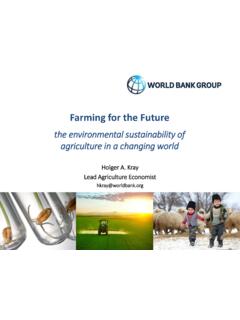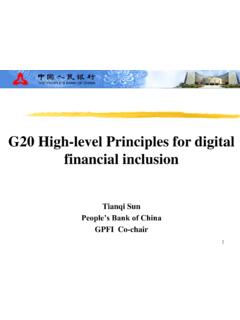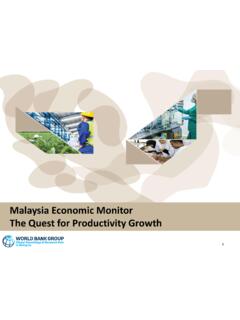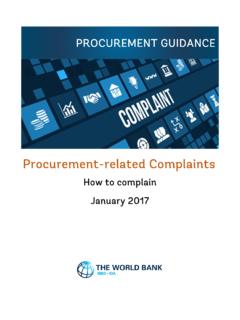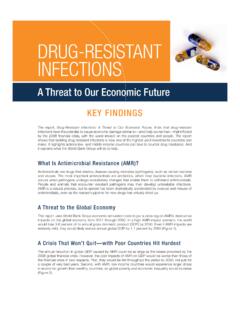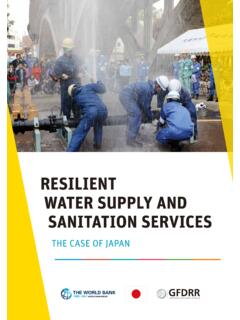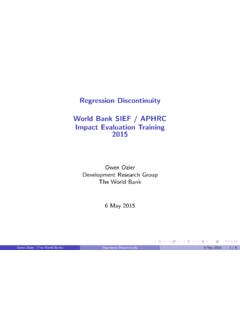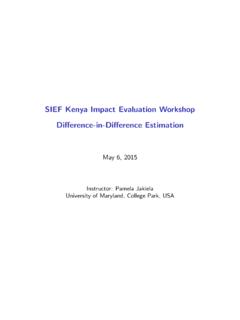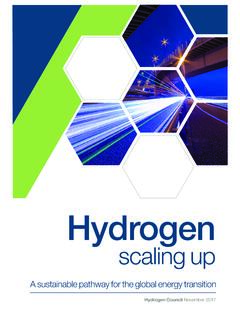Transcription of BLUE ECONOMY DEVELOPMENT FRAMEWORK
1 blue ECONOMY DEVELOPMENT FRAMEWORK . Growing the blue ECONOMY to Combat Poverty and Accelerate Prosperity The world counts numerous coastal and island countries with lower and lower-middle income levels, for whom oceans represent a significant jurisdictional area and a source of opportunity. In those countries, innovation and growth in the coastal, marine and maritime sectors could deliver food, energy, transport , among other products and services (see box below), and serve as a foundation for sustainable DEVELOPMENT . Diversifying countries' economies beyond land- based activities and along their coasts is critical to achieving the Sustainable DEVELOPMENT Goals and delivering smart, sustainable and inclusive growth globally. In Europe for example, the blue ECONOMY represents roughly million jobs and generates a gross added value of almost 500 billion a year.
2 Components of the blue ECONOMY Type of Activity Ocean Service Industry Drivers of Growth Fisheries Food Security Seafood Harvest of living Aquaculture Demand for Protein resources R&D for healthcare and Marine biotechnology Pharmaceuticals, chemicals industry Extraction of non- Minerals Seabed mining Demand for minerals living resources, Oil and gas Demand for alternative Energy generation of new Renewables energy sources resources Fresh water Desalination Demand for fresh water Shipping Growth in seaborne trade;. transport and trade Commerce and Port infrastructure and services International regulations trade in and around Tourism Growth of global tourism the oceans Tourism and recreation Coastal urbanization Coastal DEVELOPMENT Domestic regulations Ocean monitoring and Technology and R&D R&D in ocean technologies surveillance Growth in coastal and Carbon Sequestration blue Carbon ocean protection and Response to ocean conservation activities health challenges Habitat protection and Coastal Protection restoration Assimilation of nutrients and Waste Disposal wastes 1.
3 Additional growth of the blue ECONOMY is possible in a number of areas, especially: fisheries, aquaculture, mariculture, coastal tourism, marine biotechnology, and ocean energy. While some of these sectors will require little encouragement and additional governance, others need more and better planning to achieve their full potential and return more sustainable outcomes. Ambitious governance reform supported by the World Bank in Morocco for instance, helped the country develop its aquaculture sector to generate jobs, especially for women, in rural areas where employment prospects are challenging. Providing technical knowledge of marine ecosystems, legal certainty and security to attract private investment have been key success factors in that instance. Significant contributions of marine and freshwater ecosystems include: Food security, nutrition and health: Fish contributes over 16 percent of the animal protein consumed by the world's population and percent of all protein consumed, with 1 billion people relying on this source of protein.
4 Fish is also a particularly critical source of nutrition. Even in small quantities, provision of fish can be effective in addressing food and nutritional security among the poor and vulnerable populations around the globe. Livelihoods: FAO estimates that fishers, fish farmers and those supplying services and goods to related industries assure the livelihoods of as many as 660 820 million people worldwide. In addition, women play a critical role in fishery supply chains it is estimated that women account for 15 percent of people directly engaged in fisheries and up to 90 percent of jobs in secondary activities (particularly in fish processing, whether in the formal or informal sector). Oceans and coasts also form the foundation for extensive employment in tourism - one of the top five industries in most small island states.
5 Mitigation of climate change: Oceans constitute a major sink for anthropogenic emissions, absorbing 25 percent of the extra CO2 added to Earth's atmosphere by burning fossil fuels. blue carbon' sinks like mangrove forests, sea grass beds and other vegetated ocean habitats are up to five times as effective as tropical forests at sequestering carbon. Homes and shelter: Roughly 40 percent of the world's population lives within 100 kilometers of the coast. Healthy coastal ecosystems provide protection from natural hazards, coastal erosion and rising sea levels particularly in small island developing states (SIDS) and low-lying, exposed delta regions. Sustainable economic growth: A large number of developing coastal and island nations depend on tourism and fisheries for a significant part of their gross domestic product and public revenues.
6 Aquaculture is projected to continue to grow rapidly and if done sustainably, can serve as a major source of food and a cornerstone of the blue ECONOMY . Advances in seaweed production hold promise for replacing fishmeal and animal feeds with plant materials produced with less pollution. Tourism, and particularly nature-based tourism, also provides an important path towards the sustainable DEVELOPMENT of marine and coastal ecosystems. Coastal tourism is a key component of small island state economies. The value of nature-based tourism is expected to increase over time as the supply of pristine natural assets declines while demand, which seems impervious to economic shocks, increases with rising GDPs. 2. Trade: Seafood is the most highly valued internationally traded food commodity in the world, with 36 percent of all fish produced exported in 2013-2014.
7 At US$139 billion in 2013, the export value of fish is more than double that of the next most traded commodity soybeans. More than half of the fish trade originated from the waters of developing countries. Challenges undermining the blue ECONOMY The potential to grow the blue ECONOMY is limited by a series of challenges. For much of human history, aquatic ecosystems have been viewed and treated as limitless resources and largely cost-free repositories of waste. These resources, however, are far from limitless and we are increasingly seeing the impacts of this approach. The narrow coastal interface is oversubscribed by myriad sectors, and increasingly impacted by climate change. Rising demand, ineffective governance institutions, inadequate economic incentives, technological advances and insufficient management tools have led to inefficiently regulated or unregulated competition among users.
8 This in turn has resulted in excessive use, and in some cases irreversible change, of valuable aquatic resources and coastal areas. In this increasingly competitive space, the interests of those most dependent and vulnerable (for example small- scale artisanal fishers) are often marginalized. Most significant human impacts have been from: Overfishing as a result of technological improvements coupled with poorly managed access to fish stocks and rising demand. The FAO estimates that approximately 57 percent of fish stocks are fully exploited and another 30 percent are over-exploited, depleted or recovering. Fish stocks are further exploited by illegal, unreported and unregulated fishing, responsible for roughly 11 to 26 million tons of fish catches annually, or US$10-22 billion in unlawful or undocumented revenue.
9 Habitat degradation due largely to coastal DEVELOPMENT , deforestation, mining, and unsustainable fishing practices as well as pollution, in the form of excess nutrients from untreated sewerage, agricultural run-off and marine debris such as plastics. Coastal erosion also destroys infrastructure and livelihoods. Climate change related phenomena -- both slow onset events like sea level rise and more intense and frequent weather events. Long term climate change impact on ocean systems is fraught with uncertainty, but it is clear that changes in sea temperature, acidity, and major oceanic currents, among others, threaten marine life and habitats. Unfair trade: Exclusive Economic Zones (EEZ), zones in which a state has special rights over exploration and use of marine resources, are crucial to the economies of island states, and often dwarf their corresponding land mass and government's administrative capacity.
10 (In Tuvalu, for instance, the size of the EEZ is more than 26,000 times that of the land mass.). Moreover, much of the value from international seafood trade does not remain in developing countries of origin, let alone in fishing communities. Ad hoc DEVELOPMENT : Unplanned and unregulated DEVELOPMENT in the narrow coastal interface and near shore areas have led to significant externalities between sectors, 3. suboptimal siting of infrastructure, overlapping uses of land and marine areas, marginalization of poor communities, and loss or degradation of critical habitats. Despite a range of actors and large investments, current attempts to overcome these challenges have mostly been piecemeal, with no comprehensive strategy (for example fisheries governance; improving ports; marine litter efforts).
